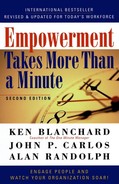THE THREE KEYS IN DYNAMIC INTERACTION
AS MICHAEL walked into Sandy’s office, he found her in a familiar pose, staring out the window. As she turned to greet him, he jumped right into his question, “So far, I’ve learned three keys to empowerment. They sound good, but do they work? Do they make a difference in performance or results?”
She responded, “Slow down a minute, and tell me what you’ve learned.”
“OK. I’ve learned that there are three keys to empowerment that are part of a process for releasing the potential that is within people.”
Michael showed her his summary notes (see next page):
After Sandy read his notes, Michael started talking excitedly again, continually referring to his cards and notes. For twenty minutes, he talked without letting her say a word. She sat back in her chair and listened intently.
When Michael finished, he was a bit out of breath. He looked at the Empowering Manager and waited for her to say something. Finally she spoke. “It’s evident to me that you understand the steps for creating an empowered organization. You get an A for your solid grasp of the main ideas.”
3 Keys to Empowerment:
- Share accurate information with everyone.
- Create autonomy through boundaries.
- Replace hierarchical thinking with self-managed teams.
“But can these three keys really lead to empowerment?” Michael asked. He had always been a bottom-line manager. “Isn’t there more? Do they really improve performance and employee satisfaction?”
“Yes, yes, and yes,” she replied with a smile. “Let me point out a few things regarding performance. This company has far exceeded even my expectations as we moved to empowerment. Now don’t misunderstand; we were the leader in our geographic area even before empowerment, but we felt we could do better. And were we ever right!”
“Since we began the empowerment process,” she continued, “our quality of customer service has exceeded 99.99 percent, while our revenue has gone up 10 percent a year and our costs have been cut 10 to 15 percent every year.
“On top of that, our people come to work excited every day; they find the increased responsibility very rewarding. And, they continue to come up with new ways to get work done faster, at lower cost, and with higher quality. They help us sense how the market is changing, and you wouldn’t believe the many creative ways they help the company keep improving and innovating. Our business is booming, and our customers love us.”
“I’m impressed,” said Michael. “Tell me more about the performance and satisfaction that results from applying each of the three keys to empowerment.”
“Once again I think you’d be better off talking to my colleagues,” Sandy insisted. She picked up the phone and called Elizabeth Meadows in Fulfillment and found that Michael could see her the next morning.
“Elizabeth has some great ideas,” she said. “She’s right there on the front line, and I think you’ll find that she’s a results-oriented manager who can give you some more insights, particularly about the impact of sharing information and creating boundaries.”
“That would be helpful,” said Michael. “Do you have any final thoughts before I head off?”
“Three,” Sandy replied. “First, as you may already have found, the three keys to empowerment are simple and easy to understand, but they are difficult to put into everyday action. Second, the process of moving people and the organization to empowerment is challenging and at times frustrating—you will want to give up many times before you get there. And, third, the three keys need to be viewed as operating in dynamic interaction with each other. While information sharing is the critical first step, empowering people takes all three keys, with a constant shifting in emphasis as needed.”
Michael nodded, thinking, All three in dynamic interaction. Then he replied, “Thanks, that helps. I’m looking forward to meeting with Elizabeth Meadows.”
